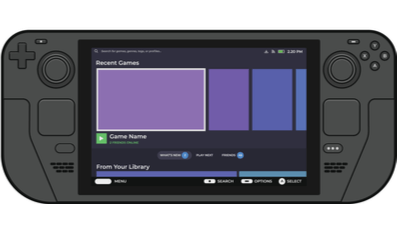Steam Deck: PC Equivalent On-The-Go?

There are currently not many portable gaming devices in the market that 100% satisfy the needs of gamers. While the Nintendo Switch is still at large, it’s not exactly meant for everyone; fans of Nintendo’s first-party titles will no doubt find something for themselves, but what about for the ones that live for third-party games and AAA titles? Emulator handhelds are certainly an option such as the Aya Neo AMD, but with a hefty price tag of $700-$900 and the Aya Neo Pro costing a lavish $1215, it can be a hard and bitter pill to swallow for folks that just want to game on-the-go. Since the recent announcement of the Steam Deck, there’s been an influx of PC gamers who would kill to get their hands on Steam’s latest portable device. Valve has claimed that the Steam Deck can be treated as a portable PC rather than a gaming console, but can this be applied in a long-term use case?
Table of Contents
The Advantage of the Steam Deck
The most notable advantage that the Steam Deck has is that it’s allegedly a PC that people can take anywhere. With a form factor that’s more or less the same size as a Nintendo Switch, players can boot up their Steam library in just a matter of seconds, away from the comforts of their PC at home. However, for those that want to treat it like their PC, then they’d want to mostly use the Steam Deck on its dock (which can be purchased separately) to connect it to a larger display like a monitor.
The idea of being able to carry around the device and also using it to connect to a monitor or a TV isn’t anything new — after all, Nintendo has already cracked the code first. But people have to keep in mind that should they purchase the Steam Deck, they’ll immediately have access to their Steam library. Steam is one of the largest video game digital distribution services to date. Made by Valve, there are thousands upon thousands of digital games that people can purchase and play using the Steam client. Of course, who can’t forget about Steam sales where folks can easily purchase great games for dirt cheap. These sales come frequently, with the largest ones being the Steam Summer and Winter Sales. Imagine obtaining an entry to such a vast array of video games with just a small device such as the Steam Deck. Wouldn’t that be a sight to behold?
Breaking Down the Steam Deck’s Specifications
The prices for the Steam Deck are $329 for the base 64GB model, while the other models that have a higher storage capacity range from $529 to $649. So just what can gamers get for all the Steam Deck models? Well, for starters, here’s a glance at some of the base specifications that are shared by all the types of Steam Decks:
- 16GB LPDDR5 RAM with 5500MT/s quad 32-bit channels
- 8 RDNA 2 CUs GPU with 1.0-1.6Hz
- Zen 24C-8T CPU with 2.4-3.5Hz
Now, looking at these specs, everything may look a tad underwhelming, especially the GPU. However, it should be worth noting that the overall performance of the Steam Deck will be greatly enhanced with the four-channel LPDDR5 RAM that sports 16GB. This is one of the latest models that advertise Low Power Double Data Rate memory. It may look like just a bunch of fancy words clumped together to make it sound like it’s the greatest thing in the world, but it’s worth raving about. This optimizes the memory of mobile hardware (such as the Steam Deck) and in turn, makes the process of running video games a smoother experience.
The GPU that the Steam Deck sports shouldn’t be scoffed at either. Based on a power-efficient architecture that’s utilized for the Steam Deck in comparison to the other video cards in the same performance class, it can be difficult to pinpoint exactly what its GPU equivalent is. But, suffice to say, if one were to compare it to something near or at least similar to it, then it would have to be the Nvidia GTX 1050. The GTX 1050 has been out for quite a few years now, and while it pales in comparison to the GPU cards that are currently in the market, it certainly gets the job done.
Finally, the CPU for the Steam Deck is a four-core/eight-thread Zen 2 CPU model. Compared to, let’s say, a Ryzen 3 3100 CPU, the Zen 2 CPU will result in the Steam Deck running a tad slower at 2.4-3.5Hz. That doesn’t mean it’s bad though — this move that Valve has made to utilize a slightly inferior chip is more likely to extend the battery life of the Steam Deck. Folks have to remember that if the Steam Deck were to be put with the latest parts and all, it would increase its thermal demand and decrease its battery life. Meanwhile, the entire AMD APU just requires 4-15W of power to keep it running.
So Can the Steam Deck Be A Permanent PC?
Upon taking a close look at the specs of the Steam Deck: as unfortunate as this sounds, it can’t be treated as a PC in the long run. While it’s perfectly doable to turn it into a makeshift PC or gaming laptop, people have to remember that hardware upgrades are an inevitable part of technology now. In just a blink of an eye, what used to be the latest in tech can become obsolete fairly quickly. What’s more, the demand for high-resolution graphics and better framerates just keeps rising. However, with the hardware shortages that’s been happening for quite a while now, prices in the current market have inflated the prices of tech parts that used to be considered slightly inferior albeit budget-friendly. Considering the current state of PC building and its prices, the Steam Deck can certainly fit the bill of being a portable device that can double as a “gaming PC”, but it’s not meant to stay in that role permanently.














